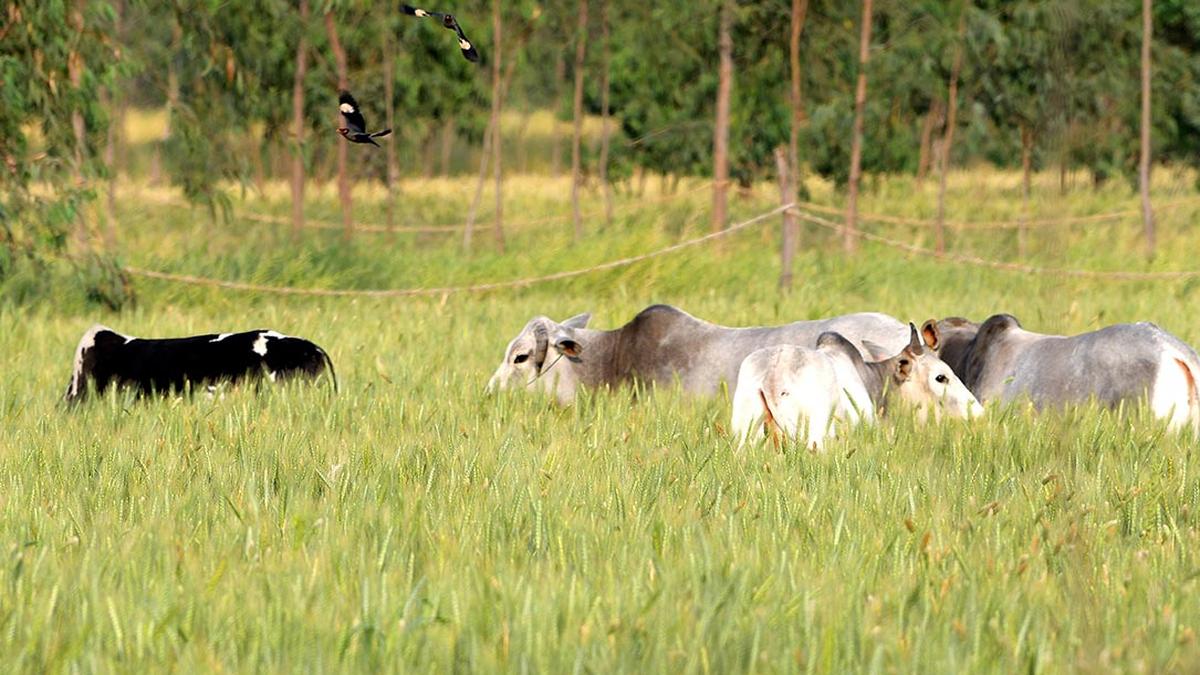
Where animals are dying by a thousand cuts Premium
The Hindu
With more than a million abandoned cattle decimating harvests and farm-based livelihoods, however, electoral winds may blow in strange directions in this largely agrarian and electorally pivotal State of Uttar Pradesh.
Elections have concluded in most constituencies in Uttar Pradesh, with unemployment, inflation, and agrarian distress likely to have been the core issues motivating the voters. With more than a million abandoned cattle decimating harvests and farm-based livelihoods, however, electoral winds may blow in strange directions in this largely agrarian and electorally pivotal State. These stray cattle, or “chutta jaanwar” as they are colloquially known, were born out of the disruptions wrought on a functioning livestock economy by state policies and state-empowered vigilantes. The transport and trade of cattle without permits has been illegal in U.P. since 1955. Cattle trade, however, thrived until recently. It was enabled by a clandestine network of traders, and the tacit acceptance of communities that the meat industry is an integral part of the livestock economy.
While the impacts of stray cattle on farm livelihoods have been widely covered, we want to highlight their toll on wildlife populations in the biodiverse Terai areas of U.P., spanning the districts of Pilibhit, Lakhimpur Kheri, and Bahraich. The U.P. Terai landscape is renowned for its thriving sugarcane agriculture and two tiger reserves that harbour populations of endangered species such as tigers, rhinoceros, swamp deer, and Bengal florican. Here, forests, grasslands, and agriculture seamlessly blend to create a vast wilderness within which people and wildlife live cheek by jowl. Paroxysmal conflicts with tigers and chronic crop losses to herbivores have been the norm across the landscape. Some people set up simple fences to protect their farms. Others, with farms adjoining protected areas, pool resources and use their influence to have fences set up along the farm-forest boundary.
With stray cattle venturing into farmlands proximate to villages and busy roads, farmers are adopting deadlier measures such as putting up razor-wire and high-voltage electric fencing. These are designed to kill or inflict debilitating injuries on anything that crosses their path. Reports of wounded cattle dying are common. But the toll these fences are likely taking on the plethora of wildlife that use these farms remains unaccounted for. In the U.P. Terai, sugarcane farmlands serve as vital wildlife movement corridors. Being able to move unhindered between protected areas is key to ensuring the survival of wide-ranging species. Ensuring this movement, while preventing and mitigating conflicts, is a huge challenge now, which is further complicated by deadly fences intended for crop-raiding stray cattle.
The potential for large populations of unvaccinated free-ranging cattle to transmit diseases such as bovine tuberculosis and lumpy skin diseases to wild populations also remains underappreciated. Multiple cases of the latter were reported recently from various districts of U.P., including parts of the Terai. The presence of large numbers of cattle within farmlands and along forest boundaries is also creating a large prey base that potentially facilitates the residence of tigers within farmlands, which creates fertile grounds for more conflicts.
Farmers recognise stray cattle as a serious menace, even as they wrestle with their beliefs in the divinity of cows. Some of their newer convictions about the extraordinariness of cows — “the only animal that inhales and exhales oxygen” — rests uneasily alongside the recognition that in terms of utility, they are outmatched by buffaloes. The ubiquitousness of tractors, the loss of grazing commons, changing aspirations, and rising input costs have made cattle rearing an increasingly impractical activity. Communities that were once pastoral have over the decades become largely agrarian, with livestock rearing primarily supporting their household needs. High-yielding buffalo breeds, so far exempt from bans on trade and slaughter, fill this niche better than cattle do. Demand for buffaloes is dented only on account of their high purchase and rearing costs.
These dueling commitments towards one’s livelihood and ideas of cultural identity result in farmers propounding innovative ideas to solve the issue. Popular among these is the suggestion that the government needs to build cow shelters, including within protected areas, to allow cattle to enjoy the forest air and readily available fodder. These sentiments mirror those expressed towards crop-raiding wildlife species in the Terai. Like many landscapes with protected areas, communities in the Terai view the tiger reserves and wildlife as exclusive government property. It is unsurprising then that they wish to see the stray cattle, which they refer to as “Yogi-Modi ki gay (Yogi-Modi’s cows)”, be cared for within the government’s protected area where, they believe, other crop raiders owned by the government reside.
Protected areas in the U.P. Terai are small, fragmented, and their most productive grasslands are declining due to environmental change. The future of several imperiled species depends on sustaining and enhancing these grassland areas. Creating cow shelters within protected areas does not serve this end. While this has not yet been mooted as a possibility by the government, given recent trends, and the fact that the U.P. government spends more on feeding stray cattle than on pensions for widows and the elderly, it is not implausible.





















 Run 3 Space | Play Space Running Game
Run 3 Space | Play Space Running Game Traffic Jam 3D | Online Racing Game
Traffic Jam 3D | Online Racing Game Duck Hunt | Play Old Classic Game
Duck Hunt | Play Old Classic Game











